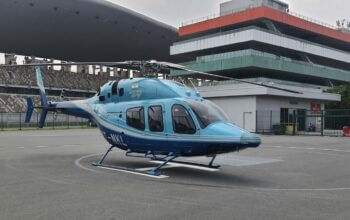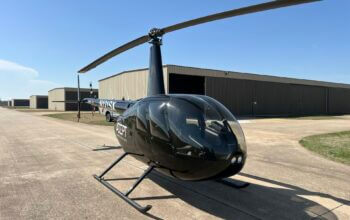This sponsored article was created by Insight magazine, the sponsored content division of MHM Publishing, on behalf of Anodyne Electronics Manufacturing Corp.
With a renewed strategic focus and some new and improved products, Anodyne Electronics Manufacturing Corp. (AEM) is poised to take its special mission avionics and structural health monitoring sensor solutions business to new heights in 2024 and beyond.
Since 2009, the AEM team has been providing high-quality, trusted products to the aviation industry. Whether it’s the digital communication system, airborne loudspeaker systems, avionics consoles, specialty audio accessories, or its newly launched mission radios, AEM’s customer-driven solutions are designed and built to meet the unique requirements of the special mission operators and integrators that they serve.

Since taking over the controls in summer 2022, Taylor Wylie, AEM’s group chief operating officer, has put the Western Canadian-based company on a course for significant growth — not only with its recently bolstered lineup of special mission avionics products, but with its cutting-edge structural health monitoring sensor solutions.
“We are entering an exciting time for our business,” Wylie said. “We have ramped up development and production of new market-leading special mission products with our digital audio and new forest service radio this year. Marry that with the massive opportunity and potential we have with our structural health monitoring sensor business, we are at the cusp of something quite special and on a significant growth trajectory as a company.”
Under Wylie’s leadership, AEM continues to offer the dedicated customer service and product support its customers know and love. The British Columbia-based manufacturer has more than 115 specialized employees at its 3,500-square-meter (37,675-square-foot) vertically-integrated facility, including a strong team of 24 engineers responsible for research and development, hardware and software development, and testing and validation.

AEM has received approval for manufacture and maintenance from Transport Canada, and part 145 maintenance organization approval from the European Union Aviation Safety Agency (EASA). As well, the company is ISO9001/AS9100D registered, and certified under Canada’s Controlled Goods Program.
Mission-ready
AEM released two new mission radios in 2023. The most recent is a modern panel-mount radio for special-role and multi-mission platforms called the MTP136D, a plug-and-play replacement for existing legacy aerial firefighting radios.
Designed with the U.S. Forest Service and aerial firefighting operators in mind, the MTP136D is a Project 25 Phase 1 compliant VHF FM solution for digital and analog communication on all channels across the 136MHz to 174MHz frequency band. Its robust design ensures the highest performance in lengthy and demanding firefighting environments.

“The MTP136D was developed in consultation with tactical aerial firefighting agencies and offers an agile P25 capable guard receiver,” said Tony Weller, AEM’s director of sales and marketing. “It supports 40 zones and 5,000 channels and has an intuitive menu-driven interface with a large [night vision imaging system] NVIS-compatible screen displaying all critical channel and operational information.”
Announced as the official launch customer, Western Canada-based company Yellowhead Helicopters was the first major service provider to place an order for the MTP136D. Yellowhead will begin updating its entire fleet with these brand-new radios in early 2024.
Specialty audio accessories
AEM also launched the BAA01 Bluetooth audio accessory, a panel-mount unit designed to add Bluetooth connectivity to existing avionics, audio, public address, or loudspeaker systems.

“The BAA01-001 helps operators of any kind securely connect their phones or other Bluetooth devices to existing aircraft audio and avionics equipment,” Weller said. “Our intention with this product is to help integrators improve the experience for operators with such a flexible and easy-to-install unit.”
The BAA01 can support discrete call and music audio using the built-in Bluetooth audio profiles. An integrated front-panel LED annunciator displays the power, pairing and link status. The operator can easily adjust control and volume of the Bluetooth audio playback using the BAA01’s built-in front panel rotary encoder.
Comparative Vacuum Monitoring
On top of its special mission avionics business, AEM also develops, manufactures, sells, and supports Comparative Vacuum Monitoring (CVM) smart sensor solutions, which is a new technology to help commercial airlines meet crack detection and inspection requirements for certain metal components of commercial airframes. Working in collaboration with Delta Air Lines and Boeing, CVM is the first approved airframe crack detection compliance sensor solution.

In 2014, AEM partnered with Structural Monitoring Systems Plc (SMS) in the development, production, and certification of the structural health monitoring (SHM) technology. For four years, AEM and SMS worked together with Boeing to develop the technology and successfully attained approval by the Federal Aviation Administration (FAA). Following the FAA approval, SMS purchased AEM in a strategic move that fully supports AEM’s avionics business and a scale-up to commercialize and take CVM to market.
Additionally, in September 2023, CVM was recognized by U.S. airline industry organization Airlines for America (A4A) for being the first regulatory-approved application of SHM by the FAA, and being the first FAA-certified, non-destructive, failsafe at-the-gate solution for achieving condition-based maintenance.

Ready to soar
Energized by its renewed focus and ambitious growth plans, AEM is looking ahead to a banner year in 2024, serving current and brand-new customers alike.
“Our purpose is clear, which helps our people bring their best selves to work each and every day for our customers,” Wylie said. “We provide reliable and trusted mission-critical products to aerial firefighters, law enforcement, search-and-rescue, and commercial airlines — all of which help keep people safe and protect important infrastructure. That’s something we can all feel incredibly proud of.”










This is promising, I dedicated my dissertation to this subject and I’m glad it is going somewhere in the industry.